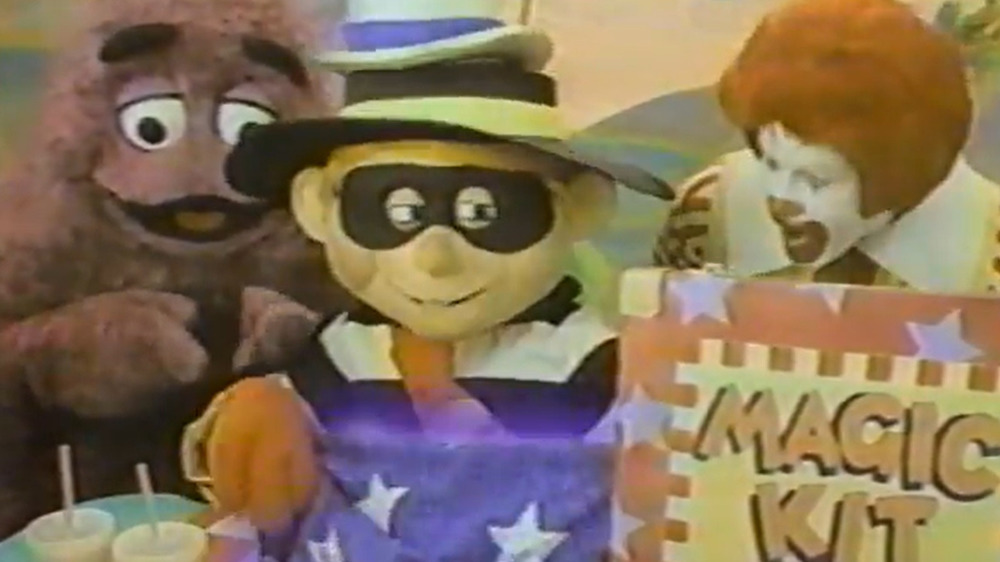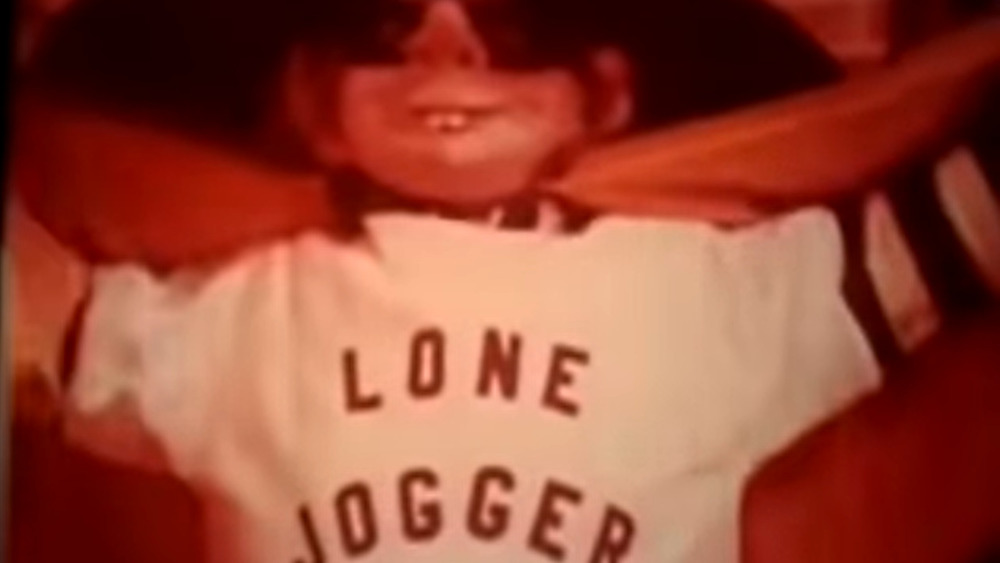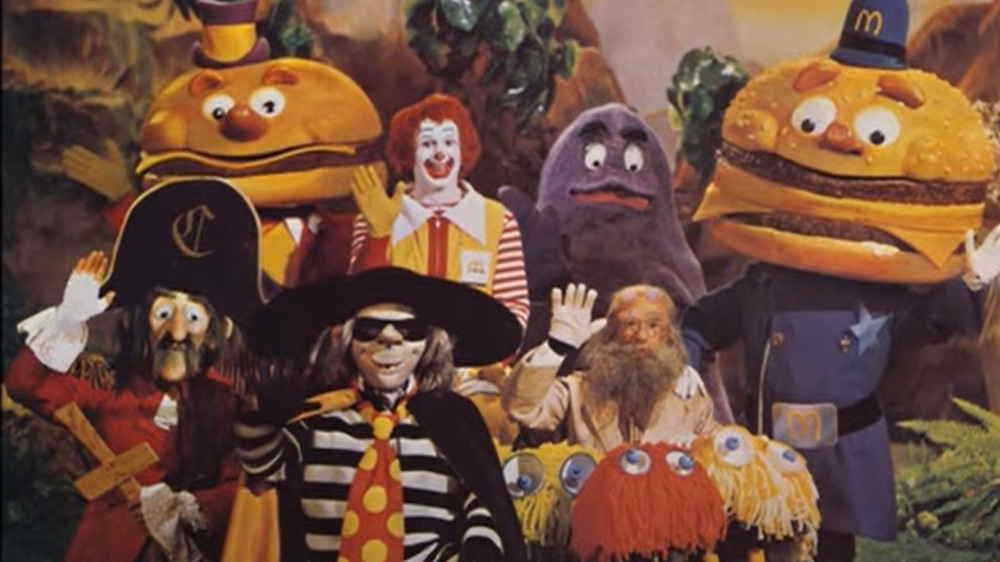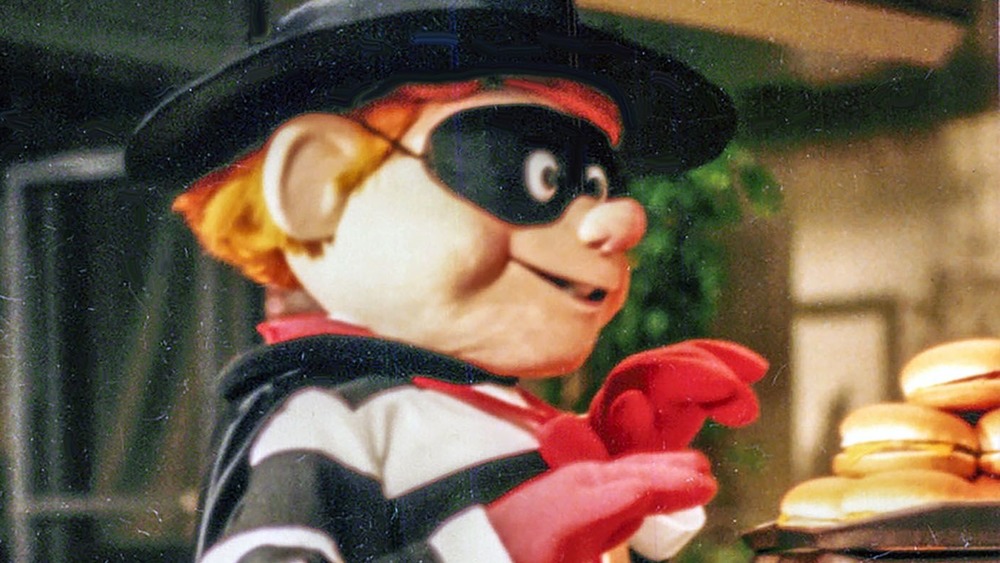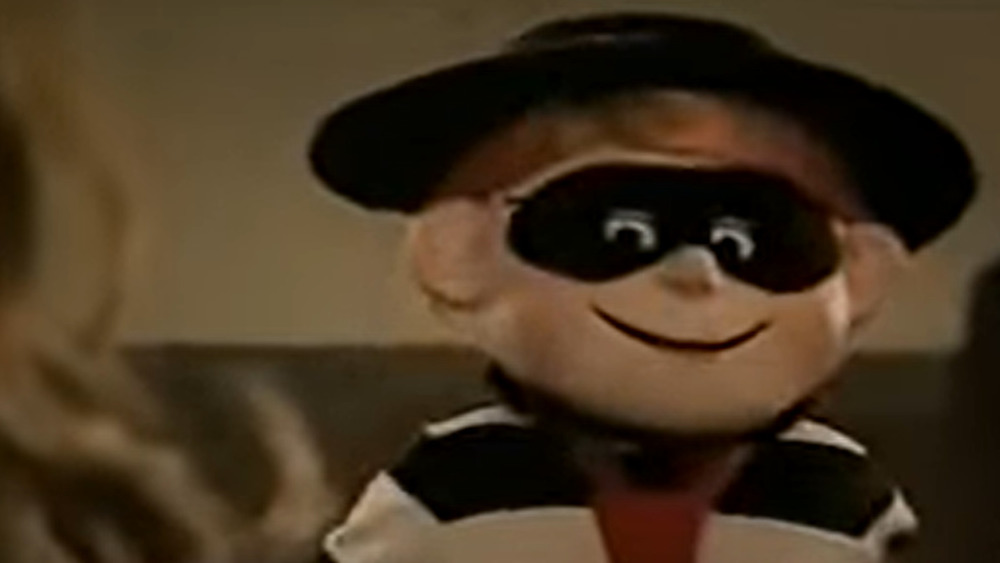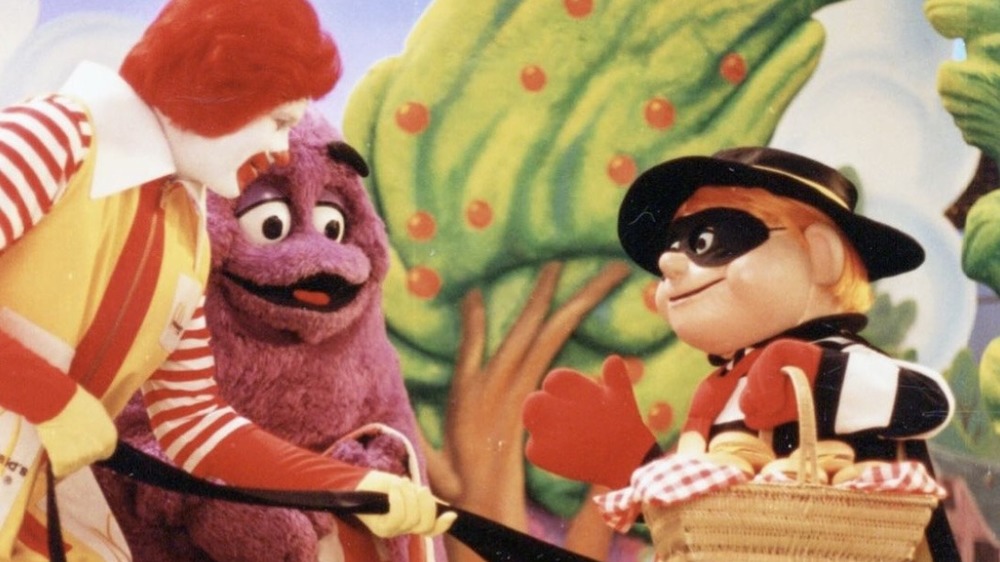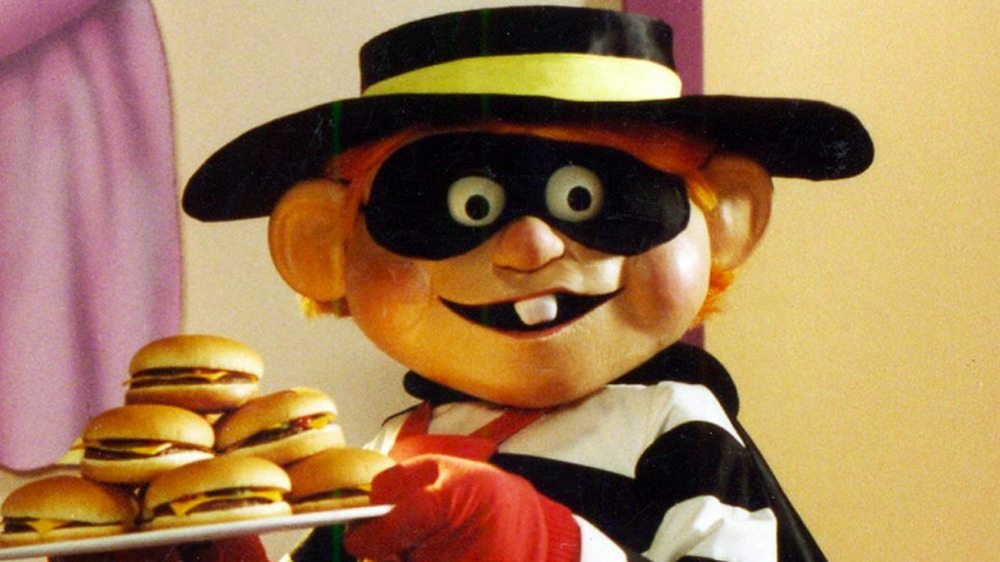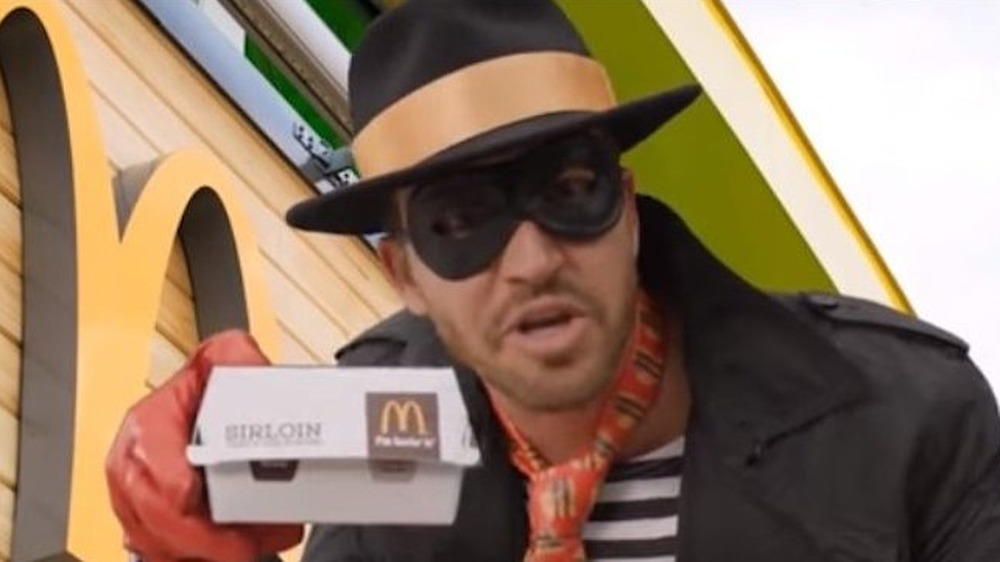The Real Reason McDonald's Got Rid Of The Hamburglar
Every hero needs a villain — someone to juxtapose against, to present the embodiment of badness to make their goodness stand out all the more. This is true even for fast food advertising characters. Years after establishing Ronald McDonald as its cheerful, kid-friendly mascot and champion of all things hamburger, fries, and shake-related, McDonald's brought out a nemesis for the clown: the Hamburglar. As the same implies, he was a criminal — although more of a thief than a breaking-and-entering practitioner — helping himself to hamburgers (or more commonly, cheeseburgers) that didn't belong to him.
Why did the Hamburglar commit such atrocities? Well, he just loved McDonald's so much that he just couldn't help but swipe the products. The Hamburglar was usually caught in the middle of an act of thievery, or by the end of one of his many in 30-second commercials, but he was never deterred, always returning with another hamburger-snatching scheme.
After about 30 years of advertising magic and appearing all over McDonald's merchandise and at in-store playgrounds, the Hamburglar disappeared. Did he finally get sent away to fast food prison, or go off to that big hamburger in the sky? Here are the real reasons why McDonald's and the Hamburglar parted ways. Roble, roble!
The Hamburglar looked... different at first
In 1970, McDonald's hired the advertising company Needham, Harper & Steers for a campaign to attract young customers. What's the best way to get kids to notice fast food? Broad characters and fantasy scenarios, perhaps? The ad pros pitched "McDonaldland," a magical world populated with creatures fueled by and obsessed with McDonald's food. Joining preexisting mascot Ronald McDonald were the shake-obsessed purple thing Grimace, the brave and good Mayor McCheese, and the villainous Hamburglar, who so loved McDonald's hamburgers that he stole them whenever he got the chance.
McDonaldland ads started airing in 1971, and they were an immediate hit. The original Hamburglar, however, did not strike as friendly and inviting an appearance as his fictional cohorts. He looked like a criminal, goblin, the Lone Ranger, and Zorro all in one. He sported a long and crooked nose, wild hair under a floppy hat, an eye mask with matching cape, and a black-and-white striped outfit commonly associated with inmates — with a few teeth missing to complete the look.
For a while, the Hamburglar was called the Lone Jogger — a cryptic moniker that he wore on a T-shirt underneath all those other clothing layers. That's seemingly a play on "Lone Ranger" and a nod to how the Hamburglar would "jog" into celebrations and steal burgers. Eventually, the character was revised in 1985, when he was given red hair and smoother facial features to make him look more childlike and cartoonish than creepy and menacing.
The Hamburglar used to have some more company
While the Hamburglar eventually became a direct nemesis of Ronald McDonald — and to a lesser extent, the other "good guys" of the McDonald's commercials — in the early 1970s, the Hamburglar once had another adversary named Officer Big Mac. Officer Big Mac, who is now retired, looked like an English constable who, like Mayor McCheese, had a giant hamburger for a head.
The Hamburglar didn't always work alone, either. When the character debuted in the 1970s, he had a partner in crime. Captain Crook, whose whole thing was obsessively snatching McDonald's Filet-O-Fish sandwiches like some kind of pescatarian Hamburglar, hung out and worked with the Hamburglar to commit crimes. Captain Crook also translated his associate's nonsensical gibberish and ramblings into English for the benefit of McDonaldland's other residents and TV viewers.
McDonald's has periodically revamped the Hamburglar and his surroundings over the decades, and Captain Crook disappeared after a McDonaldland revamp in the 1980s, Mental Floss reports.
McDonald's got sued all the way to McDonaldland
The commercials set in McDonaldland, a wonderful place despite the Hamburglar, fit in well amid Saturday morning TV. In the '70s, the programming block featured many bizarre, live-action shows produced by Sid and Marty Krofft, including The Bugaloos and H.R. Pufnstuf. According to Mental Floss, McDonaldland and the characters of H.R. Pufnstuf bore some striking similarities: McDonald's Mayor McCheese and Pufnstuf both had huge heads and wore sashes indicating their status, and both ruled over magical places — McDonaldland and Living Island, respectively. The ads and show also shared a similar production design. That all seemed fishier than a Filet-o-Fish to the Kroffts, who sued McDonald's and advertising firm Needham, Harper & Steers.
Per the suit: In 1970, an executive at the ad agency contacted Marty Krofft about creating a campaign for McDonald's. After several consultations, the Needham rep said they'd need to pay the Kroffts for the art and engineering plans on which they'd contributed, yet when Krofft followed up, the agency told him the ad campaign was off.
But it wasn't, of course, and McDonaldland commercials hit TV in 1971, produced in part with former Krofft employees. In 1977, courts ruled in favor of the Kroffts, citing copyright infringement. McDonald's was ordered to stop airing ads featuring Mayor McCheese and to pay the Kroffts $1 million in damages. How did all that affect the Hamburglar? It made McDonald's more vigilant with its ads — lest they violate another trademark.
McDonald's tried to use the Hamburglar to change its image in the early 2000s
In 2002, the Hamburglar made a rare appearance in a McDonald's commercial not specifically oriented to kids, when he showed up alongside tennis legends Serena and Venus Williams to promote the chain's Dollar Menu offerings. According to The Atlantic, this marked the final entry in a long line of Hamburglar-featuring advertisements.
This last gasp of relevance for the Hamburglar reflected a downturn in fortunes overall for McDonald's: In 2002, the company's stock fell by 39 percent, and the chain lost more than $435 million in value. McDonald's responded to the stock tumble by closing numerous locations and cutting a large swath of jobs, according to CNN.
The next year McDonald's set out to thoroughly and aggressively revamp and rebrand itself and its food. According to CNN, that involved more consciously competing with on-the-rise competitors like Burger King and Wendy's, making its food taste more sophisticated and mature, and introducing adult-baiting menu items like a line of salads. Using its resources to these ends meant something had to give for McDonald's, and that something was the kids' stuff. Looking to the future and to older customers meant a clean break with the way they'd done things in the past, such as utilizing a lineup of creatures and characters to sell its food. In other words, McDonald's began downplaying its McDonaldland characters, particularly the Hamburglar.
McDonald's was blamed for the rise in childhood obesity
The Hamburglar's early-2000s banishment may also be tied to controversies surrounding childhood obesity and how McDonald's Happy Meals could affect kids' diets. In 2002 and 2003,just around the time that the Hamburglar quietly stopped showing up in commercials, McDonald's faced a lawsuit over its alleged role in making kids unhealthy, CNN reports.
In August 2002, the parents of two medically overweight teenagers sued McDonald's for not properly informing the public that McDonald's food contained high amounts of fat, sugar, and salt, and the suit also alleged that the chain's offerings were responsible for the daughters' obesity, heart disease, high blood pressure, and high cholesterol. The plaintiffs' attorney, Samuel Hirsch, told CNN that his team was "not looking to get rich from a large money settlement" but wanted to create "a fund that will educate children about the nutritional facts and contents of McDonald's food."
McDonald's won the suit (a New York judge dismissed it), but it still brought bad press to the company and made millions at least consider the idea that McDonald's food could make kids unhealthy. It seemed like a PR disaster, and McDonald's certainly wasn't going to aggressively market to kids — with ads featuring the kid-friendly Hamburglar — after that.
The Hamburglar's time had passed
Marketing and advertising are all about emphasizing the new or the improved. Companies spend millions to persuade customers to buy their goods and services, and ads aim to differentiate those items from the competition by making them look interesting, fresh, and even revolutionary. That philosophy means that specific ad campaigns have a short or limited shelf life — how can a product be taken seriously as a new and amazing novelty if the commercials used to sell it are so old-fashioned and routine that they won't attract attention?
Take McDonald's, for example. The fast food conglomerate introduced its McDonaldland world in 1971, and the last ad to feature the Hamburglar character (until a later revival) hit TV in 2002. That's a lifespan of 30 years for the character, and by the end he was likely starting to seem tired and dated. The Hamburglar dressed vaguely like the title character from The Lone Ranger, a radio and TV show popular with kids in the 1950s — and that cultural touchstone was mostly unfamiliar to the target audience of kids in the 2000s. It's also entirely possible, as suggested by Time, that viewers found him creepy, which is straight-up toxic for a brand.
A changed Hamburglar made a comeback in 2015
And so, by the 2010s, the Hamburglar was gone, but he was hardly forgotten. Like a lot of other pop culture and food icons from the '70s, '80s, and '90s, he was fondly remembered by Generation Xers and Millennials who saw him wreak havoc for Ronald McDonald and the McDonaldland gang thousands of times on Saturday morning TV or during after-school cartoons. And also, like a lot of other late-20th century pop culture, the Hamburglar returned in a rebooted, updated, and more sophisticated form.
In 2015, when the Hamburglar emerged from exile, he was no longer a short, real-life cartoon character but rather a tall handsome gentleman with stubble wearing a Hamburglar-inspired outfit of long trench coat, striped shirt, eye mask, and brimmed hat tipped ever so slightly. "We felt it was time to debut a new look for the Hamburglar after he's been out of the public eye all these years," McDonald's marketing V.P. Joel Yashinsky told Mashable. "He's had some time to grow up a bit and has been busy raising a family in the suburbs and his look has evolved over time."
Not only had the Hamburglar grown up, but so had his tastes — McDonald's used the updated character as an attention-getting, limited-time-only mascot to promote its adult-oriented Sirloin Third Pound Burger in a series of online advertisements.
